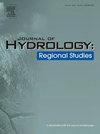A novel structural equation modelling-based framework for identifying hydrometeorological multi-factor interaction
IF 4.7
2区 地球科学
Q1 WATER RESOURCES
引用次数: 0
Abstract
Study region
The Hanjiang River Basin, China.
Study focus
In this study, we proposed a new integrated framework based on structural equation models to identify hydrometeorological multi-factor interaction relationship. The spatiotemporal distribution and interaction relationship of hydrological, meteorological, and vegetation indicators in the Hanjiang River Basin were analyzed based on the national long-series monitoring data.
New hydrological insights for the region
The findings reveal that: (1) The rainfall is the maximum in the lower reaches (968.87 mm), and the runoff depth fluctuated the most in the lower reaches (1181.70 mm to 2934.88 mm). (2) Dew point temperature is an important influencing factor of rainfall in the upper and middle reaches, and relative humidity is an important influencing factor of rainfall in the lower reaches. High vegetation cover is an important influencing factor for runoff depth. (3) Rainfall and runoff depth are significantly negatively affected by meteorological characteristics, with effect values ranging from −0.24 to −0.68. However, runoff depth is positively affected by rainfall, relative humidity, vegetation characteristics, and canopy interception, with effect values ranging from 0.02 to 0.58. The size and mode of influence have significant regional differences.
基于结构方程建模的新型水文气象多因素相互作用识别框架
研究区域中国汉江流域。研究重点在本研究中,我们提出了一种基于结构方程模型的新型综合框架,以识别水文气象多因素相互作用关系。基于国家长序列监测数据,分析了汉江流域水文、气象和植被指标的时空分布和相互作用关系:(1) 下游降雨量最大(968.87 毫米),下游径流深波动最大(1181.70 毫米至 2934.88 毫米)。(2)露点温度是中上游降雨的重要影响因素,相对湿度是下游降雨的重要影响因素。植被覆盖率高是径流深度的重要影响因素。(3) 降雨量和径流深受气象特征的显著负向影响,效应值在-0.24 至-0.68 之间。然而,降雨量、相对湿度、植被特征和冠层截流对径流深度有正向影响,效应值在 0.02 至 0.58 之间。影响的大小和方式具有显著的地区差异。
本文章由计算机程序翻译,如有差异,请以英文原文为准。
求助全文
约1分钟内获得全文
求助全文
来源期刊

Journal of Hydrology-Regional Studies
Earth and Planetary Sciences-Earth and Planetary Sciences (miscellaneous)
CiteScore
6.70
自引率
8.50%
发文量
284
审稿时长
60 days
期刊介绍:
Journal of Hydrology: Regional Studies publishes original research papers enhancing the science of hydrology and aiming at region-specific problems, past and future conditions, analysis, review and solutions. The journal particularly welcomes research papers that deliver new insights into region-specific hydrological processes and responses to changing conditions, as well as contributions that incorporate interdisciplinarity and translational science.
 求助内容:
求助内容: 应助结果提醒方式:
应助结果提醒方式:


